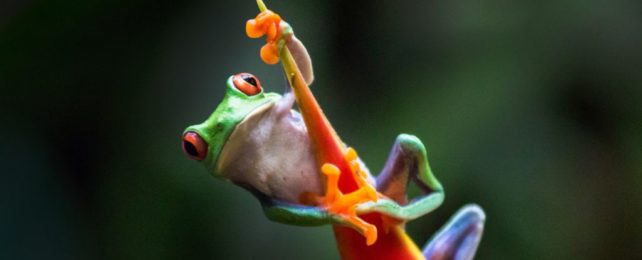Since the global pandemic began in 2020, the world has become ever more aware that the health of our species is closely intertwined with other animals. Today, the conversation is mostly focused on birds and mammals, with amphibians rarely considered – but that may be a dangerous oversight.
A newly published study on frogs and malaria illustrates how intimately human health may be impacted by these lovable – if somewhat slimy – creatures.
In the 1980s, ecologists in Costa Rica and Panama began to notice a quiet and dramatic decline in amphibian numbers.
Frogs and salamanders in this part of the world were falling prey to a virulent fungal pathogen (Batrachochytrium dendrobatidis), and they were doing so at such a rapid rate that researchers at the time feared a wave of local extinctions.
Some scientists now argue this pathogen, called Bd for short, has caused "the greatest recorded loss of biodiversity attributable to a disease" ever, being responsible for significant declines in at least 501 amphibian species, including 90 extinctions, from Asia to South America.
That's obviously a massive claim, but amphibians are now considered among the most threatened groups of animals on Earth, and the worldwide spread of this fungus and others like it are at least partly to blame.
Frogs and salamanders directly influence mosquito population sizes because mosquitoes are a key source of food, which means the numbers of amphibians could ultimately influence the vectors – living organisms that can transmit infectious pathogens – that spread deadly human diseases.
Using Central America as a case study, researchers have now tried to illustrate how creatures like frogs may ultimately benefit human health.
The findings, which were first presented in 2020, have now been peer-reviewed, and they show that Bd-driven amphibian losses led to a substantial increase in the incidence of malaria – a disease transmitted by infected mosquitoes – first in Costa Rica in the 1980s and 1990s, and then again in Panama in the early 2000s, as the fungus spread east.
To the authors' knowledge, this is the first causal evidence of amphibian losses impacting human health in a natural setting.
The study relied on a multiple regression model to estimate the causal impact of Bd-driven amphibian decline on malaria incidence at the county level in Costa Rica and Panama.
Comparing an amphibian decline map and malaria incidence map between 1976 and 2016, researchers found a clear pattern that could be predicted with high accuracy and confidence by their model.
In the eight years after substantial amphibian losses from Bd, there was a spike in malaria cases equivalent to about one extra case per 1,000 people. This extra case would, in all probability, not have come about had it not been for the recent amphibian die-off.
In a usual outbreak of malaria, incidence rates usually peak from about 1.1-1.5 cases per thousand people. This means a loss of amphibians in Central America could have possibly driven a 70-90 percent increase in how many people were getting sick.
"The pattern shows a west-to-east wave spreading from the northwestern border of Costa Rica around 1980 to the Panama Canal region by 2010," the authors write in the paper.
After eight years, though, the estimated effect is suddenly reduced, and researchers aren't sure why.
Perhaps, the authors suggest, an uptick in malaria cases prompts greater use of insecticides, which then lowers cases again in line with this cycle.
Future studies on other mosquito-borne diseases, like dengue, could help support the connection between amphibian loss and a rising threat from mosquito-borne diseases.
Researchers were only able to obtain some national data on dengue cases in Panama, not county-level data, but at this lower resolution, the findings also suggest an increase in dengue following amphibian decline.
From 2002 to 2007, the increase in dengue cases relative to the previous eight years was 36 percent.
"This previously unidentified impact of biodiversity loss illustrates the often hidden human welfare costs of conservation failures," the authors write.
"If scientists and decision-makers fail to reckon with the ramifications of such past events, they also risk failing to fully motivate protection against new calamities, like international spread of an emergent and closely related pathogen Batrachochytrium salamandrivorans through incompletely regulated live species trade," they add.
As you read this, B. salamandrivorans is hitching a ride around the world with global trade, and it threatens not just the future of amphibians but the health of our own species.
As the current study reveals, frog and human health often go hand-in-hand. We're stuck together whether we like it or not.
The study was published in Environmental Research Letters.
